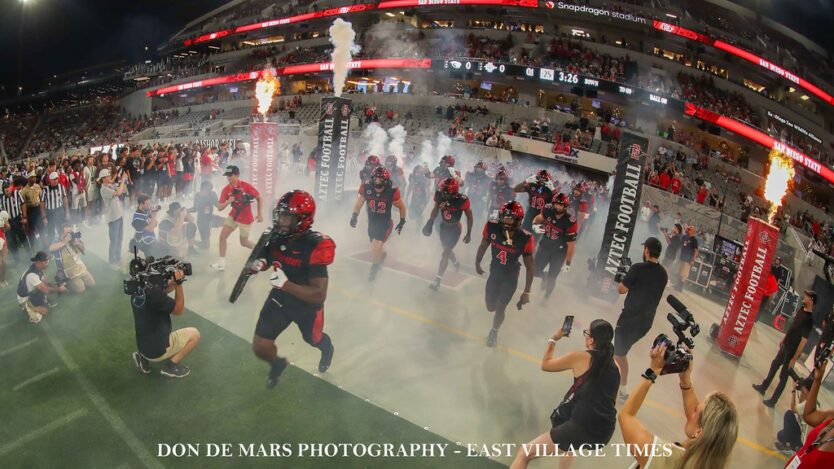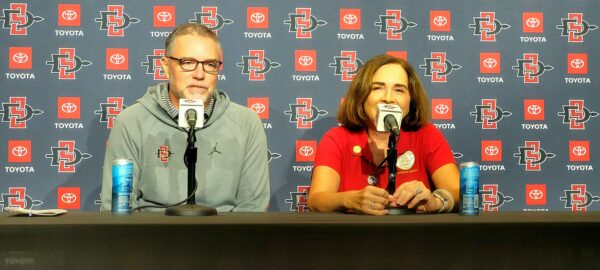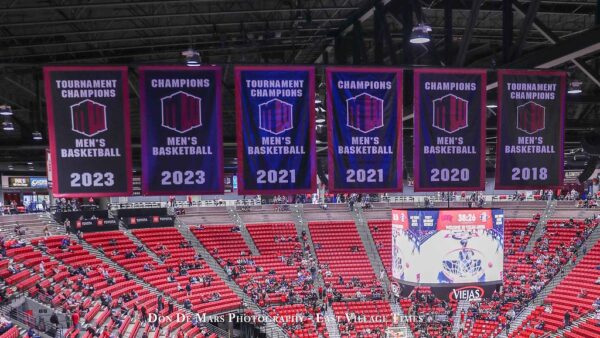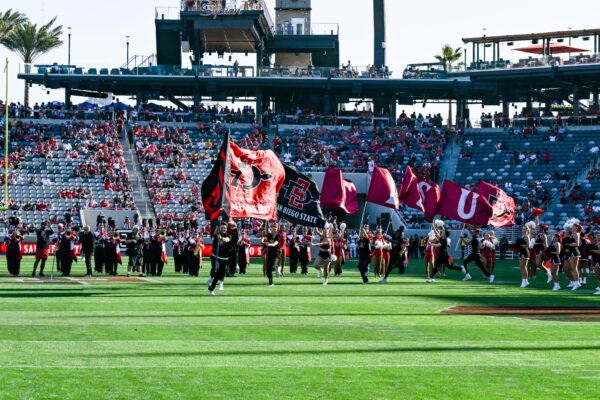SDSU catches a wave in conference realignment

SDSU runs out of the tunnel against Oregon State. In a few years this will be annual rivalry in the Pac-12 (Don De Mars/EVT)

Conference realignment has swept across college athletics. After years of watching the waves crash around it, SDSU pulled out its surfboard and took a ride.
Late Wednesday night, Yahoo Sports broke the story that the Pac-12 will be adding the Aztecs, Boise State, Fresno State, and Colorado State. Thursday morning, the move became official.
“The key to this is constantly improving yourself,” SDSU Director of Athletics JD Wicker said this morning. “We always want to not just look at the short term, but what is going to be the potential long term gain. We think this move is going to give us the best opportunity as you look at revenue generation, as you look at the playoff, as you look at NCAA basketball, all the other sports. … this is definitely a step forward for San Diego State.”
SDSU was among the founding members of the Mountain West Conference. The Aztecs called the MWC home for a quarter of a century. Now, it joins a league with 108 years of tradition, trying to rebuild after it was gutted last summer.
“Athletics is the front door for an institution, and if you look at any major public university, athletics is critical,” SDSU President Adela de la Torre said. “… Unequivocally, when I came here about seven years ago, I saw this potential. I saw it not just in football and basketball. I saw it in swim and dive, in golf, in tennis, in soccer, in volleyball. … what’s really critical here is also the potential of how this is going to amplify all of (SDSU’s) activities. … what people need to understand is we received hundreds of millions of dollars in publicity as the result of the success of athletics.”
Getting something done
By adding the top four programs from the Mountain West, Oregon State, and Washington State began a process to keep the Pac-12 viable. More schools will be added. The NCAA requires at least eight schools to qualify as a conference. The Pac-12 is in the midst of a two-year window to make that happen.
In September of 2024, it is impossible to know what the college football landscape will look like in the coming years. What is important is that SDSU is evolving with it.
The Aztecs were among the losers when the Pac-12 was reduced to two schools in August 2023. SDSU was on the cusp of a Pac-12 invite before the Big Ten lured Washington and Oregon to join UCLA and USC’s exodus. Wicker said he was at a hotel in Canton, Ohio, awaiting the hall of fame induction of former Aztec head coach Don Coryell last summer when the deal the university had in place fell apart.
Thursday’s announcement reminds the country that SDSU is a program worthy of inclusion at the highest levels. By making a move, they position themselves to ride the coming waves of conference realignment.
“All the presidents (of the four schools) were able to assess this,” de la Torre explained. “We had very good data available to us about best and worst-case scenarios. We did our due diligence. We looked at the context of potential media deals … I can’t share everything that came into it. We worked with our legal counsels. We worked with our ADs. In that sense, we felt that we were able to move forward, understanding that all of us would be taking shared risks. When we’re talking about rebuilding a conference, we have to accept the fact that there is risk involved.”

Fewer Mouths to Feed
SDSU helped create the MWC because the WAC had ballooned in size, stretching media rights money thin. With fewer partners to divide it with, more found its way to The Mesa.
This move to the Pac-12 has the same feel to it. While conferences around the country are increasing in size, a good argument can be made that sleeker versions can work, too. A media group like the CW, Amazon, or TNT that wants to enter the college football arena can do so with a much lower overall investment.
While the Pac-12 brand leaves open the possibility for an automatic bid to the college football program, SDSU will likely continue to be outside a power conference. With fewer mouths to feed, however, the gap between it and the Big-12 and ACC will be smaller.
In the coming year, more teams from the MWC could be added to this new era of the Conference of Champions. Former Pac-12 schools could realize the grass was not greener in other leagues. The Pac-12 could also convince the top schools in the American Athletic Conference that a partnership is in their best interest.
Whatever the final makeup, the Pac-12 could resemble SDSU’s current conference home. However, it ends up the Aztecs will no longer be tied with the fate of schools not willing to invest enough to compete at the highest levels.
When asked about the potential size of the Pac-12, Wicker interestingly split his reply between football and men’s basketball. Could the new conference be looking to add schools without football, like Gonzaga?
“You need to be, at a minimum, nine football-playing schools so you can have eight (games) for conference,” Wicker said. “I’d like one or two more potentially as you look at basketball scheduling and wanting to probably be at 18 conference games.”
“We’re going to go out and find the best schools and if that ends up being a larger number or just eight, we’ll figure it.”

Inside track to the College Football Playoff
Last summer, after the Pac-12 imploded and the refurbished Big XII took shape, there was a consensus that SDSU missed an opportunity because it favored the Pac-12. On Thursday, Wicker gave more details to that decision.
From a media rights perspective, he admitted, the overall dollar amount would be higher in the Big XII, but it would not be worth the added cost of travel and the inequality it would produce.
Wicker explained that under the offer from the Big XII, the Aztecs would have been more than a hundred million dollars behind the rest of the conference by the end of the television deal. Even if they received a full share at that point, it would have created an insurmountable gap.
On paper, every Big XII member has access to the college football playoff. In reality, only a few teams in the league have a shot at it. Wicker pointed out that Stanford and Cal’s decision to join the ACC is going to hamstring their ability to compete in the ACC. The Cardinal and Golden Bears technically have an automatic bid to the postseason, but does anyone expect them to challenge Clemson and Florida State?
“The thing you have to look at is what your financial package is versus everybody you’re competing against in your league and is it a place where you think you can stay competitive,” Wicker explained. “Which leads into access to College Football Playoff and NCAA Basketball Tournament. If you’re constantly looking up at everyone because they have so much more from a resource standpoint – and those people aren’t really interested in resourcing you – then you have to look, ‘where am I going to be in a place where I have fairly evenly resourced, where they want to invest in (San Diego State) for who we are?’”
“Where the Pac-12 ends up, right now, I would assume, you’re fighting for that one Group of Five or whatever you’re going to call this slot. I would say at San Diego State, we have a better shot at that than probably 40 of the Power Four schools.”
Wicker and de la Torre praised the Mountain West throughout their comments. They noted the relationships they have formed and the heights their athletic programs reached while in the conference.
But, as this wave of conference realignment formed, it was too good to pass up.
My earliest sport’s memory involve tailgating at the Murph, running down the circular exit ramps, and seeing the Padres, Chargers and Aztecs play. As a second generation Aztec, I am passionate about all things SDSU. Other interests include raising my four children, being a great husband and teaching high school.